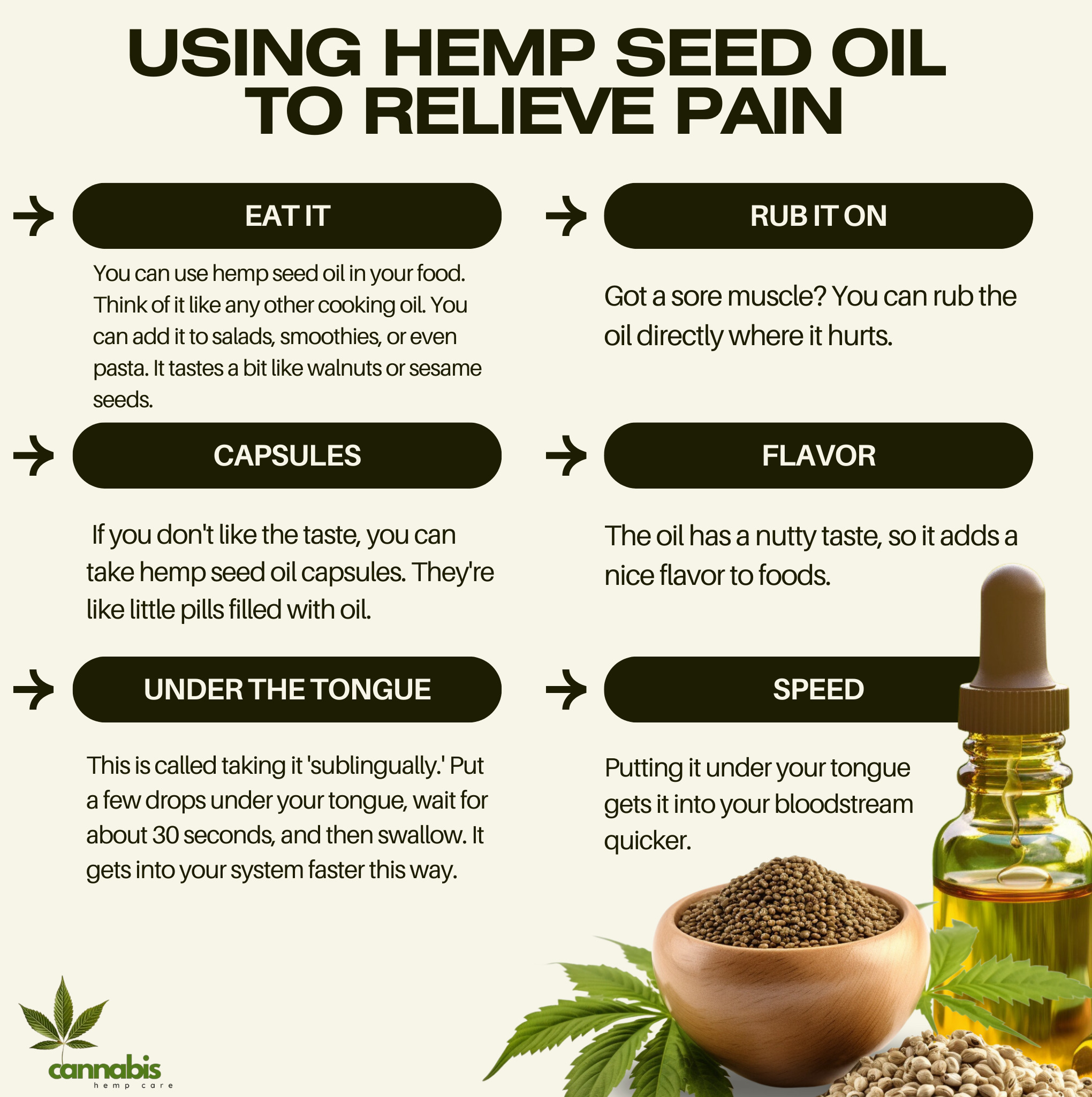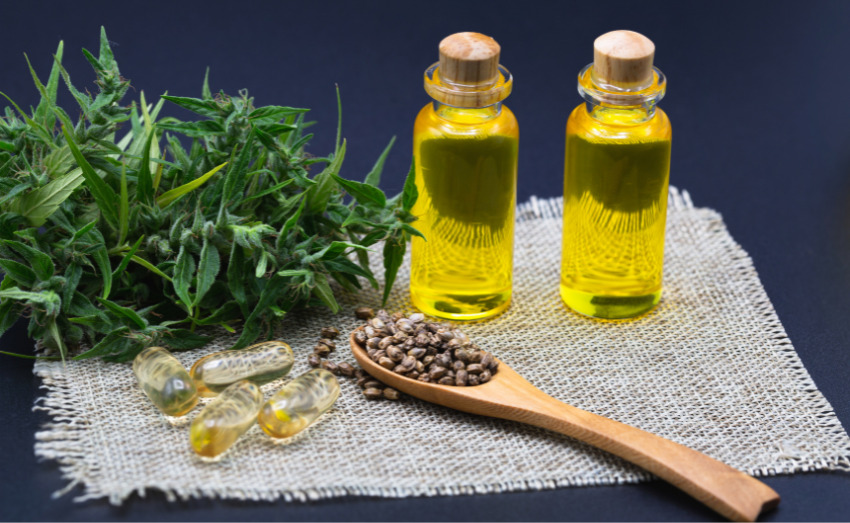Hemp Seed Oil, a derivative of the Cannabis sativa L species1, has been at the forefront of the health and wellness industry for its multitude of benefits.
Contrary to some misconceptions, hemp seed oil contains less than 0.3% tetrahydrocannabinol (THC)2, the psychoactive compound found in high amounts (up to 28%) in certain strains of the cannabis plant.
Consequently, hemp seed oil offers the benefits of cannabis without the risk of intoxication.
Chemical Composition
Hemp seed oil is renowned for its nutritional profile, which is rich in essential fatty acids. Approximately 70 to 90% of its composition consists of polyunsaturated fatty acids like linoleic acid and gamma-linolenic acid (GLA).
Its unique 3:1 ratio of omega-6 to omega-3 fatty acids is particularly noteworthy, along with its antioxidants (Vitamin E), phytosterols, and minerals like calcium, magnesium, and potassium3.
How to Use Hemp Seed Oil to Relieve Pain
If you’re dealing with pain and have heard that hemp seed oil might help, here’s how you can use it effectively.

Quick Tips for Using Hemp Seed Oil for Pain
- Eat It: You can use hemp seed oil in your food. Think of it like any other cooking oil. You can add it to salads, smoothies, or even pasta. It tastes a bit like walnuts or sesame seeds.
- Capsules: If you don’t like the taste, you can take hemp seed oil capsules. They’re like little pills filled with oil.
- Under the Tongue: This is called taking it ‘sublingually.’ Put a few drops under your tongue, wait for about 30 seconds, and then swallow. It gets into your system faster this way.
- Rub It On: Got a sore muscle? You can rub the oil directly where it hurts.
- Flavor: The oil has a nutty taste, so it adds a nice flavor to foods.
- Speed: Putting it under your tongue gets it into your bloodstream quicker.
That’s it! You can choose any of these ways based on what you’re comfortable with. The goal is to help you find some relief from your pain.
To answer this question:
For pain relief, Apply hemp seed oil directly to the injured area or absorb it through meals, pills, or 30 seconds under the tongue for pain relief. It’s anti-inflammatory and helps relieve pain naturally.
Potential Attributes and Benefits of Hemp Seed Oil
- Extraction Process: Hemp seed oil is obtained through cold pressing raw seeds, mirroring olive oil production.
- Nutritional Value: A powerhouse of nutrients, it boasts high levels of antioxidants, essential vitamins A and E, and vital minerals like calcium, manganese, potassium, and zinc.
- Fatty Acids: Packed with heart-healthy Omegas 3 and 6, it complements a balanced diet.
- Skin, Hair, and Nails: Offers rejuvenation and strengthens skin, nails, and hair.
- Inflammation and Pain Relief: Acts as a natural remedy to alleviate inflammation, reduce muscle tension, and provide pain relief.
- Cardiovascular Health: Aids in maintaining and promoting cardiovascular health.
- Dietary Inclusion: It’s a perfect choice for those adhering to vegetarian and vegan diets.
- Allergen Awareness: Typically free from common allergens, it is suitable for most individuals.

Hemp Seed Oil vs. CBD Oil For Pain
Hemp seed oil and CBD oil for pain relief, both derived from the Cannabis sativa plant species, have distinct origins and applications in various products. Here’s a concise comparison:
| Feature | Hemp Seed Oil | CBD Oil |
|---|---|---|
| Source Plant | Cannabis sativa | Cannabis sativa (both hemp and marijuana varieties) |
| Plant Part Used | Seeds | Leaves, stalks, and flowers |
| THC Content | Less than 0.3% | Varies (can be less than 0.3% or higher) |
| Common Uses | Beauty products, food | Therapeutic, pain relief, and dietary supplements |
| Primary Components | Fatty acids, vitamins | Cannabinoids, terpenes, and flavonoids |
| Available in Products | Lotions, shampoos, and cooking oils | Tinctures, capsules, creams, and edibles |
When selecting a cannabis-based product for pain relief, it’s essential to know the differences between hemp seed oil and CBD oil.
While hemp seed oil offers a range of benefits, CBD oil is more commonly associated with pain relief. Always consult a healthcare provider for personalized advice.
Potential Risks and Side Effects
As beneficial as hemp seed oil can be for health, it’s vital for users to recognize and navigate its potential pitfalls. Let’s delve into the possible risks and best practices for its use.
1. Low Flash Point: Avoid high-temperature cooking with hemp seed oil as it may destroy its beneficial components, such as linoleic acid and gamma-linolenic acid4.
2. Risk of Rancidity: Exposure to air and light can cause the polyunsaturated fatty acids in hemp seed oil to oxidize, leading to rancidity and a loss of beneficial antioxidants like Vitamin E.
3. Storage Guidelines: Store hemp seed oil in a cool, dark place with the container tightly sealed to prevent oxidation and rancidity.
4. Digestive Discomfort: Limit daily intake to around 2 tablespoons on a 2,000-calorie diet to minimize the risk of gastrointestinal issues like bloating or diarrhea.
5. Drug Interactions: Consult your healthcare provider before using hemp seed oil with blood thinners to prevent potential interactions.
Note:
Being aware of the potential risks ensures that you can maximize the benefits of hemp seed oil for pain while minimizing its limitations. A well-informed user is a safer user.
Amounts and Dosage
For a balanced 2,000-calorie diet, between 1-2 teaspoons or one tablespoon (15 milliliters) of hemp seed oil daily is recommended. One tablespoon contains:
- Saturated fatty acids: 1 gram
- Calories: 125

Conclusion
The health advantages of hemp seed oil for pain include skin enhancement, natural pain treatment, and more. Although typically safe, visit a doctor for personalized advice if you are pregnant, nursing, or taking other drugs.
Hemp seed oil has many health benefits and few adverse effects, making it an interesting candidate for clinical study and therapy.
FAQs
What does hemp seed oil do for pain?
Hemp seed oil possesses anti-inflammatory properties that can assist in alleviating pain.
How long does hemp seed oil take to work?
Typically, it takes around 15 to 45 minutes for hemp seed oil to start showing effects.
Is hemp seed oil a painkiller?
While hemp seed oil is not a traditional painkiller, its anti-inflammatory properties can help reduce pain.
How many times a day should I take hemp seed oil?
For optimal benefits, we recommend ingesting up to 5 tablespoons of hemp seed oil a day.
What does hemp seed oil do for pain?
Hemp seed oil possesses anti-inflammatory properties which can assist in alleviating pain.
Is hemp seed oil safe for all ages?
Yes, hemp seed oil is generally safe for all ages, but it’s always best to consult with a healthcare provider before starting any new supplement.
Is hemp seed oil the same as CBD oil?
No, while both are derived from the cannabis plant, hemp seed oil is extracted from the seeds and doesn’t contain CBD, while CBD oil is made from the plant’s leaves, flowers, and stalks and contains cannabidiol (CBD).
Sources
- Contributors, WebMD Editorial. “Health Benefits of Hemp Seed Oil.” WebMD, www.webmd.com/diet/health-benefits-hemp-seed-oil#:~:text=Hemp%20seed%20oil. Accessed 14 Sept. 2023. ↩︎
- “What Is Hemp Seed Oil?” The Brothers Green, 7 July 2023, thebrothersgreen.co/blogs/learn-more/what-is-hemp-seed-oil. Accessed 14 Sept. 2023. ↩︎
- “12 Incredible Uses for Hemp Seed Oil” Www.blueskyhempventures.com, www.blueskyhempventures.com/blue-sky-thinking/12-incredible-uses-for-hemp-seed-oil/. Accessed 14 Sept. 2023. ↩︎
- “How Hemp Seed Oil Can Aid Pain Relief. Rich in Omega 6 and Omega 3 – WholyMe.” Wholyme.com, 25 May 2022, wholyme.com/blogs/wellness-routine/hemp-seed-oil-pain-relief/. Accessed 14 Sept. 2023.. ↩︎




































